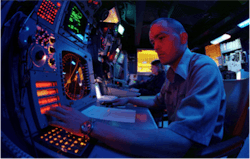Growing Importance of Electronic Warfare
The growing importance of Electronic Warfare
Electronic Warfare (EW) is becoming one of the most talked about topics in the defense industry today. For the last 20 years or longer, with the exception of counter-IED technologies, EW was largely put on the back burner. But now the need to deal with peer and near-peer adversaries and have the ability to enter anti-access/area denial (A2AD) environments is critical and has brought EW to the forefront.
As a result, the market for EW is expected to grow. One appraisal by Markets and Markets estimates the global electronic warfare market was $17.72 billion in 2014 and is expected to register a CAGR of 5.37%, reaching $24.25 Billion in 2020. Another report from Strategy Analytics, Inc. sees the growth driven by the need to operate across wider bandwidths and at higher frequencies while generating suitable output power coupled with the ability to be portable. The Department of Defense is increasing its investments and recently identified seven Science and Technology(S&T) priorities with one:s game is developing rapidly.Warfare/Electronic Protection. ments and recently identified seven Science and Technology(S&T) pri being Electronic Warfare/Electronic Protection. The other six are Autonomy, Counter Weapons of Mass Destruction, Cyber Science and Technology, Data‐to‐Decisions, Engineered Resilient Systems, and Human Systems.
Some recent press coverage highlights this focus on EW. Here are some examples:
Overview of EW
As described by various organizations, the three pillars of Electronic Warfare are:
- Electronic Attack (EA) – the use of electromagnetic energy, directed energy or anti-radiation weapons to attack personnel, facilities or equipment with the intent of degrading, neutralizing or destroying enemy combat capabilities
- Electronic Protection (EP) – actions taken to protect personnel, facilities and equipment from any effects of friendly or enemy use of the electromagnetic spectrum that degrade, neutralize or destroy friendly combat capabilities
- Electronic Support (ES) – actions tasked by or under the direct control of, an operational commander to search for, intercept, identify and locate sources of intentional and unintentional radiated electromagnetic energy for the purpose of immediate threat recognition, targeting, planning and conduct of future operations.
In essence, EW is a cat and mouse game. One side devises a new EA method and the other side figures out a way to protect against it. With the constant advances in electronics, this game is developing rapidly and the various branches of the U.S. military are trying to move quickly to keep up. The “bible” of EW for the U.S. is the Joint Publication 3-13.1 Electronic Warfare. This document provides the joint doctrine for EW across a range of military operations.
In addition, each branch has several publications on the subject. Here are a select few.
- The U.S. Navy Information Operations NWP 3-13
Another key resource for EW is the Association of Old Crows (AOC). This is an international professional organization specializing in electronic warfare, tactical information operations, and associated disciplines. They hold several events throughout the year addressing key EW technologies and have many resources including webcasts, a monthly magazine and a recommended reading list.
New Whitepaper Discusses EW trends
The additional element of the critical DoD priorities around the Pacific Pivot, the challenges of Asia Pacific deployment and the “tyranny of distance” given the vast geography of the region, renewed instability in Northern Africa and the Middle East, and challenges in Eastern and Central Europe, have all turned Electronic Warfare from being “a priority” to “the priority” in modern defense. This holds true for both the United States and our allies around the globe.
This whitepaper examines the challenges we face as a nation and within the defense industrial base around EW and provides context on how we believe these challenges should be addressed. Topics include:
- Highlights of key components of EW - including deceptive jammers and denial jamming, countermeasures, and threat analysis
- Discussion on the role of Open Systems Architectures within EW
- Presents a path forward for the future of EW that meets the challenges of today and tomorrow
Click here to download the Whitepaper
Other EW Resources
To learn more, here are other resources about EW:
- DSP for SIGINT and EW – a 20 minute recorded webcast where Mercury Systems’ Chief Technologist Lorne Graves reviews the latest processing technologies.
- DRFM Jammers for EA – a whitepaper that explores the role of Digital RF Memory (DRFM) based jammers in modern deceptive ECM systems and the simulation of these systems to evaluate vulnerability to jamming techniques.



